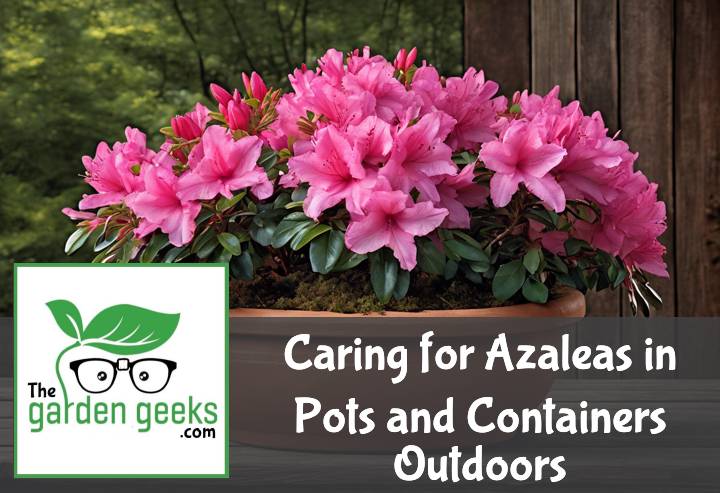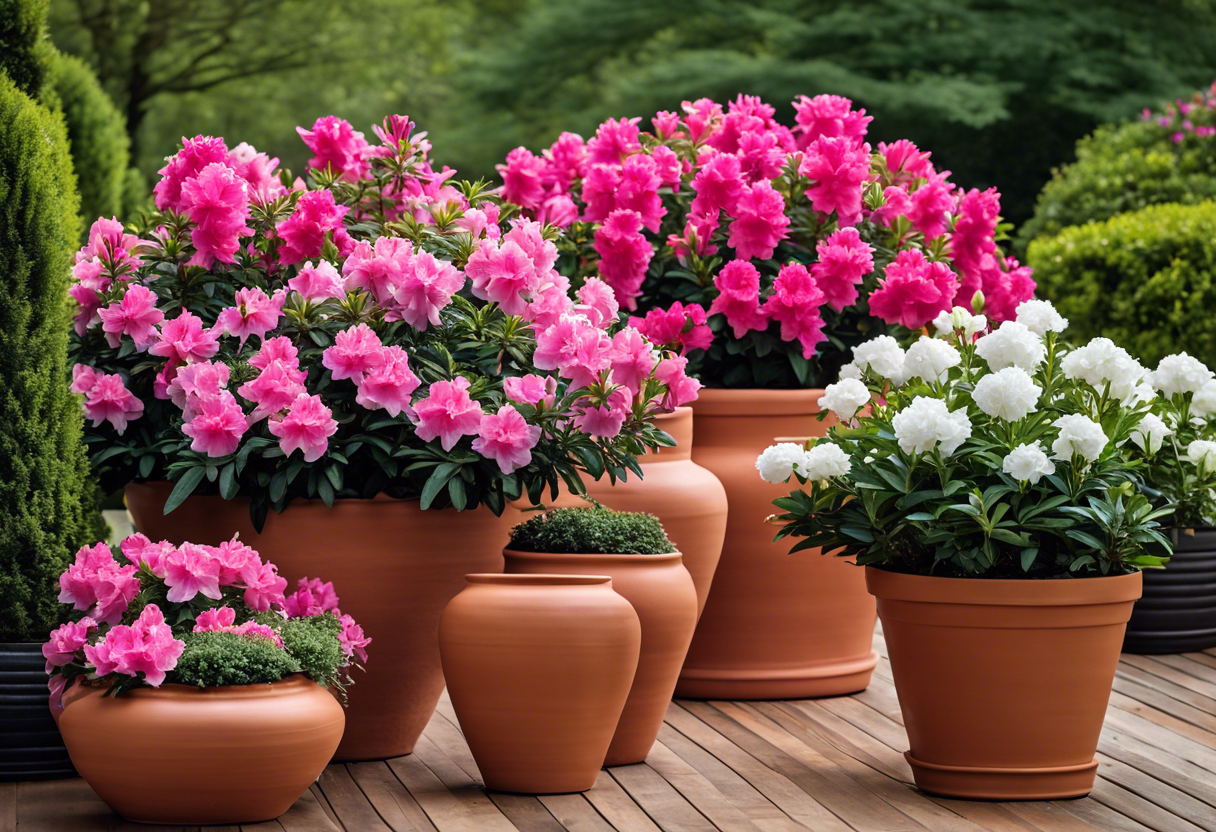Well, hello there fellow green-thumb enthusiasts! Have you ever considered Caring for Azaleas in Pots and Containers Outdoors? No? Then buckle up, as we’re about to embark on a journey into the world of these vibrant beauties.
Azaleas, with their riotous colors and lush blooms, can turn any outdoor space into a magical garden wonderland. And guess what? They’re not as high-maintenance as you might think! So let’s dive into the nitty-gritty of how to keep these blooming divas happy and healthy in their pot homes. Keep reading about Caring for Azaleas in Pots and Containers Outdoors.
Key Takeaways
- Azaleas thrive in pots with good drainage and acidic, well-draining soil.
- They prefer a location with morning sun and afternoon shade.
- Regular watering is crucial but avoid waterlogging.
- Fertilize azaleas in late winter or early spring using a slow-release, acid-forming fertilizer.
- Prune after blooming to maintain shape and promote bushier growth.
- Protect potted azaleas from extreme cold by moving them indoors or insulating the pot.
What are Azaleas?
Azaleas, my friend, are the life of the party in any garden. These garden favorites are part of the Rhododendron family and known for their vibrant hues. They’re like nature’s fireworks display – just without the noise! And guess what? They’re perfect for container gardening too!
Brief Overview of Azaleas
Now, let’s talk about these beauties’ features. Azaleas are flowering shrubs that come in various sizes. Some stay small and compact, while others can grow quite large. Their flower colors range from white to pink, red, and even purple.
These plants have a unique growth habit that makes them stand out. They tend to grow in a dense, bushy manner which gives them a full and lush appearance. Plus, they’ve got this cool thing going on where they bloom all at once during their blooming season, creating an explosion of color.
Different Types of Azaleas Suitable for Pots and Containers
Not all azaleas are created equal when it comes to potting though. Some varieties just love being in pots or containers outdoors more than others. Let me introduce you to some container-friendly azalea types.
The ‘Girard’s Fuchsia’ is one such variety that loves container living. It has deep pink flowers and enjoys cooler climates. Another type is the ‘Stewartstonian’, with its fiery red blooms that can brighten up any space.
Each type has its own specific care needs so remember – when it comes to caring for Azaleas in pots and containers outdoors, one size doesn’t fit all!
Why Grow Azaleas in Pots and Containers Outdoors?
If you’re a fan of outdoor azalea care, then you’ve probably considered growing azaleas outdoors. But why not take it a step further? Why not try your hand at container gardening? It’s all about giving those gorgeous potted azalea plants the best chance to thrive. And trust me, an azalea container garden can be a sight for sore eyes!
Benefits of Container Gardening for Azaleas
You see, there are several advantages to growing these beauties in containers. For starters, it gives you the flexibility to move them around. You can place your container grown azaleas wherever they’ll get the best light or shelter from harsh weather.
Another great thing about this method is the ease of care. With benefits of potted azaleas like these, who wouldn’t want to give it a shot? Plus, when it comes to caring for azaleas in pots and containers outdoors, you have more control over soil conditions and watering.
Ideal Conditions for Outdoor Azalea Growth
Now let’s talk about creating the perfect environment for your potted pals. The optimal conditions for azaleas involve a delicate balance of sunlight and shade. These plants love some good morning sun but appreciate some afternoon shade.
The next thing on our list is moisture. Azaleas aren’t big fans of dry soil, so make sure their pots have good drainage to prevent waterlogging. Remember, when it comes to caring for azaleas in pots and containers outdoors, every detail matters!
How to Choose the Right Pot or Container for Your Azaleas?
When it comes to Caring for Azaleas in Pots and Containers Outdoors, picking the right home is crucial. The material and size of your pot can make a world of difference. So, let’s dive into choosing Azalea pots and containers.
Material Considerations for Pots and Containers
First up, let’s talk about materials. Different materials can have varying impacts on your azalea’s health and growth. Plastic pots are lightweight and affordable, but they might not offer the best insulation against temperature changes.
On the other hand, ceramic pots can be pretty heavy but they’re great at retaining moisture. However, they can also become quite cold during winter months which isn’t ideal for our leafy friends.
Then there’s terracotta – a classic choice for many gardeners. These pots are breathable which helps prevent root rot, but they do tend to dry out faster than others. So, when it comes to material for Azalea pots, there’s no one-size-fits-all answer – it depends on your specific situation and Azalea potting tips you follow.
Size and Depth Requirements for Healthy Azalea Roots
Now onto size and depth requirements. The right pot size is vital in promoting healthy root development in azaleas. Too small, and your plant might become root-bound; too large, and it could drown in excess water.
As a rule of thumb, opt for a container that’s about 2 inches larger in diameter than the root ball of your azalea plant. This gives enough room for roots to grow without being overly spacious.
Depth is equally important here folks! Shallow pots may cause roots to dry out quickly while deep ones might lead to waterlogging issues. Aim for a pot depth that is roughly equal to the height of the root ball. Remember, healthy azalea roots in pots are the key to a thriving plant! So, keep these optimal pot dimensions for azaleas in mind when you’re out shopping for your next Azalea home.
How to Plant Azaleas in Pots and Containers?
When it comes to planting azaleas in pots, there’s a bit more to it than just digging a hole. It’s all about the soil preparation, pH levels, and the actual planting procedure. Let’s dive right into it.
Soil Preparation and pH Levels
First off, preparing soil for azaleas is crucial. You can’t just use any old dirt from your backyard. Azaleas prefer well-drained, organic-rich soil that allows their roots to breathe.
Now let’s talk about pH levels. The ideal pH for azalea plants is slightly acidic, between 4.5 and 6.0. If your soil isn’t naturally within this range, don’t fret! There are plenty of ways to adjust the soil pH for azaleas like adding sulfur or iron sulfate.
Planting Procedure
Alrighty then, let’s get down to business – the actual azalea planting steps. Start by choosing a pot that has good drainage and is wide enough for your azalea bush.
Next up in our adventure of container gardening with azaleas, place some of your prepared soil in the bottom of the pot before gently placing your azalea on top.
Finally, fill around the plant with more soil, making sure not to bury the stem too deeply. And voila! You’re now an expert at caring for Azaleas in pots and containers outdoors!
How to Care for Your Potted Outdoor Azaleas?
When it comes to Caring for Azaleas in Pots and Containers Outdoors, there are a few essentials you need to keep in mind. We’re talking about watering, fertilization, and pruning. These are the cornerstones of good Outdoor Azalea care and will ensure your Potted Azalea maintenance is top-notch.
Watering Guidelines
First things first, let’s talk about watering. You see, Watering outdoor Azaleas isn’t just about drenching them with water every now and then. It’s more about understanding their hydration needs.
Azaleas love moisture but hate being waterlogged. So, the trick is to keep them moist but not soaked. This means watering them thoroughly when the top inch of soil feels dry.
Also, remember that weather conditions play a big role in determining how often you should water your azaleas. In hot weather, they might need daily watering while in cooler months, once or twice a week would suffice.
Fertilization Needs
Next up on our list is fertilization – an important aspect of Caring for Azaleas in Pots and Containers Outdoors that often gets overlooked.
Azaleas aren’t heavy feeders but they do appreciate some extra nutrients from time to time. A slow-release fertilizer designed for acid-loving plants like azaleas works best here.
Timing is also crucial when it comes to fertilizing your potted azaleas outdoors. The best time is early spring before new growth starts so that the plant can make use of all those nutrients during its growing phase.
Pruning Techniques
Last but not least, we have pruning – an essential part of any good Potted Azalea maintenance routine.
Pruning isn’t just about maintaining aesthetics (although a well-pruned azalea is indeed a sight to behold!). It’s more about promoting healthy growth and keeping diseases at bay.
The best time to prune your outdoor azaleas is after they’ve finished blooming. This way, you won’t accidentally snip off any of next year’s flowers. Just remember to keep it light – excessive pruning can stress the plant out.
Common Problems with Outdoor Potted Azaleas and Their Solutions
When it comes to Caring for Azaleas in Pots and Containers Outdoors, there are a few common problems you might encounter. But don’t fret, we’ve got the solutions for these Outdoor Azalea Problems.
Identifying Common Diseases and Pests
First off, let’s talk about Identifying Azalea Diseases. If your azalea’s leaves start to yellow or wilt, it could be a sign of root rot. On the other hand, if you notice spots or discoloration on the leaves, that could indicate a fungal infection.
Now onto pests – those pesky little critters! The most Common Pests on Azaleas include lace bugs and spider mites. Keep an eye out for tiny white spots on the underside of leaves or a general lackluster appearance as signs of pest infestation.
Effective Treatment Methods
So how do we deal with these issues? For diseases, consider using a fungicide treatment. It’s one of the best methods when it comes to Treating Diseased Azaleas.
As for those annoying pests, introducing natural predators like ladybugs can help keep them in check. This is an Effective Pest Control for Azaleas method that doesn’t involve harsh chemicals.
Remember folks, Caring for Outdoor Potted Azaleas isn’t always easy but with some vigilance and care, your azaleas will thrive!
To Wrap Up
In the grand garden party of life, think of Azaleas as the divas who need a little extra TLC. We’ve learned that Caring for Azaleas in Pots and Containers Outdoors is like babysitting a fussy toddler – demanding but rewarding.
So go on, roll up those sleeves and give your green babies some love! Remember, happy Azalea, happy life!





